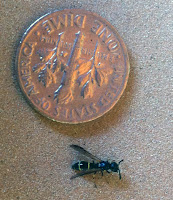 |
| Mason Wasp sized by a dime |
After flipping through some books and surfing images on the Internet, we determined the insect was a mason wasp, also known as a potter wasp. For the scientists in the room, this collection of insects is classified in the subfamily of Vespidae with other wasps and hornets, and it is sometimes recognized more specifically in a separate family as Eumenidae.
Mason wasps are a predatory insect that feed on the larva of other insects and build nest with mud but at times will dwell in holes of wood for nesting purposes. They also build mud walls to divide and seal their chambers. Though they may be seen flying in and out of holes in the logs of your home, chances are they didn't make the holes. They are probably using preexisting holes for their nests, and so other than a nuisance they are of no particular harm. They can even be beneficial as they prey on tent caterpillars/army worms, and other problematic larva.
If they are found to be a pest and extermination is the goal, insecticides can be put in the holes, which can later be disguised by a log home caulk. Because of the mud barriers they put up to protect larva, it is wise to poke a wire into the hole before applying an insecticide to break their mason walls.
Photo credit: Julie Johnsen
|
